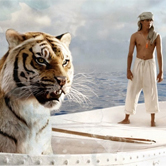Ang Lee’s ambitious adaptation of Yann Martel’s novel, Life of Pi, has been compared to Avatar, and while both films are, in part, an effort to explore the creative and expressive potentials of new technologies in film, the similarities stop there. Lee’s film is visually ambitious, and some of its most memorable shots are amalgamations of real and “unreal” elements, CGI and photographic cross-overs that make a boat floating on the ocean look like a vessel floating in space. But the movie is also coy and subtle, a meditation on the meaning of religion, the reality of violence, and most significantly, the nature of fiction.
The film is about the incredible survival of Pi Patel (played by Suraj Sharma as a youth, and Irrfan Khan as the older Pi), who finds himself shipwrecked and trapped in a lifeboat with a menagerie of creatures, including a tiger named Robert Parker, after his failed hunter. How did we get here? Pi’s family owned a farm, and when his father decided to move the family to Canada, they take some of the animals with them. There’s a storm, and by the blindest of luck, Pi is in the boat with Robert Parker, a chimpanzee, a wounded zebra, and a hyena.
We begin the film in the present, with the somewhat hokey framing devise of a journalist visiting an older Pi after he has heard that Pi has an incredible story to tell. That story begins in Pi’s coastal Indian village, where the boy is a kind of religious dabbler, adopting for stretches of time the religions that are practiced in his village: Hinduism, Catholicism, and Islam. Then there is his father, an ardent rationalist, who chaffs at the boys eagerness to lose himself in mystic pursuits. It sets the stage for the ocean-born showdown with brute elements of nature: man and sea, man and beast.
Pi’s struggle to survive is the central focus of most of Lee’s drama. Pi must come up with desperate and ingenious ways to outlast his many days at sea. The young believer ropes himself to the boat during the storm and challenges the all-powerful, but Life of Pi is more directly a story of personal resilience, of learning the limits of individual capability through suffering, and arriving at a more nuanced understanding of our reliance – physically and psychologically – on the rest of creation, even the bits that seem out to get us.
And yet what lingers at the end of Life of Pi, almost despite itself, is the impression created by a sudden plot twist that reveals the author and filmmaker’s intentions. Ironically for a film that will likely garner a lot of attention for its ability to push the potential of the visual imagery in popular cinema, Life of Pi is a film about texts, fiction and sacred texts – how they mean and the implication of that meaning.






